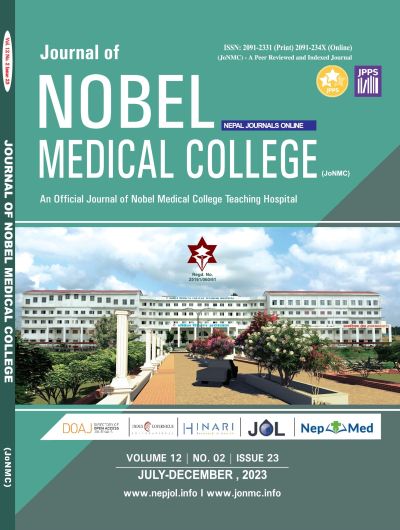Scrub Typhus Associated Secondary Hemophagocytic Lymphohistiocytosis in Pediatric Intensive Care Unit
DOI:
https://doi.org/10.3126/jonmc.v12i2.61351Keywords:
Hemophagocytic lymphohistiocytosis, Prognosis, Scrub TyphusAbstract
Background: Scrub Typhus is febrile illness caused by orientia tsutsugamusi and presents with multiorgan involvement. It can cause multiorgan failure resulting in acute respiratory distress syndrome, acute kidney Injury and hemophagocytic lymphohistiocytosis. Secondary hemophagocytic lymphohistiocytosis is rare but life threatening clinical condition caused by uncontrolled activation of inflammatory cytokines and accumulation of activated macrophages and lymphocytes.
Materials and Methods: This study is a prospective observational study conducted on children with Scrub Typhus being admitted to Pediatric Intensive care Unit of Nobel Medical College during 12 months period from July 2022 to June 2023. Basic demographic features, clinical presentation, severity and outcome were analyzed. Categorical variables were reported as frequencies, and continuous as mean ± SD. Independent sample t-test and chi square test was used for comparison of means and categorical variables.
Results: A total of 32 children with scrub typhus were included. Common age group was >10 years. Fever, hepatosplenomegaly, rash and respiratory distress were common clinical features. Among 32 cases, 7 (21.87%) had Encephalitis, 10 (31.25%) developed acute respiratory distress syndrome, 13 (40.62%) had Shock, and 9 (28.12%) developed secondary hemophagocytic lymphohistiocytosis. Among 9 children with scrub typhus associated secondary hemophagocytic lymphohistiocytosis, all of them had Hyperferritenemia, Hypofibrinogenemia, and Hypertriglyceridemia. Hemophagocytosis was identified in (55.55%) in bone marrow biopsies. 1 patient succumbed to multiorgan failure.
Conclusion: Secondary hemophagocytic lymphohistiocytosis should be considered in children with Scrub typhus requiring Intensive care support. Early recognition and prompt treatment can result in good outcome in children with Scrub typhus associated secondary hemophagocytic lymphohistiocytosis.
Downloads
Downloads
Published
How to Cite
Issue
Section
License
Copyright (c) 2023 Sandip Kumar Singh, Shishir Jha, Rajnish Mishra, Sajan Kumar Thakur, Suja Gurung, Aliza Bajracharya

This work is licensed under a Creative Commons Attribution 4.0 International License.
JoNMC applies the Creative Commons Attribution (CC BY) license to works we publish. Under this license, authors retain ownership of the copyright for their content, but they allow anyone to download, reuse, reprint, modify, distribute and/or copy the content as long as the original authors and source are cited.




